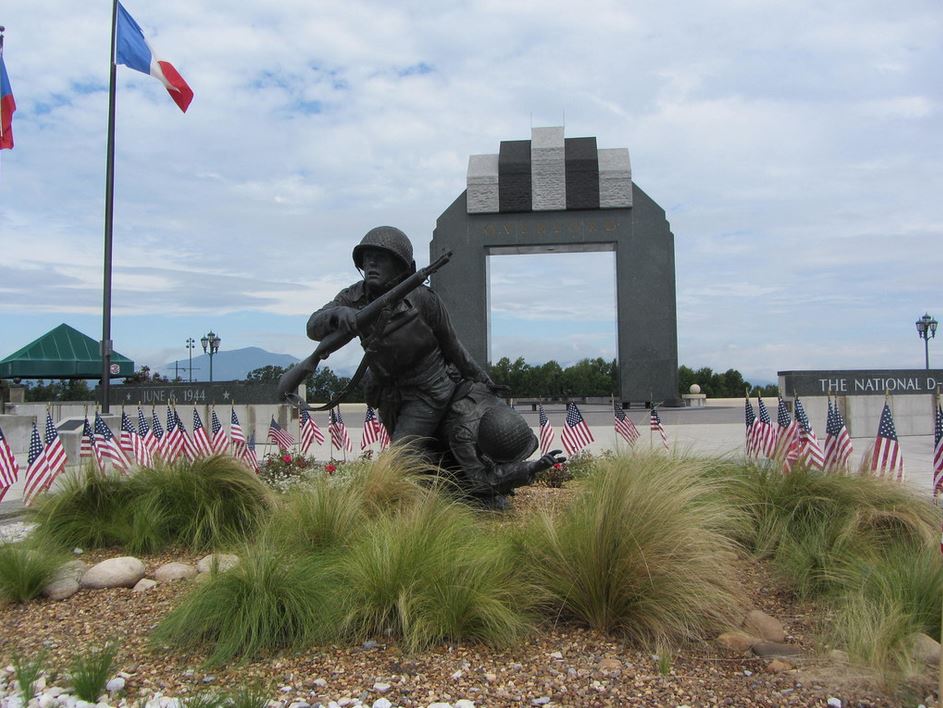Why was a small town in central Virginia chosen as the site of the national memorial for American D-Day veterans? Contemporary issues of the Bedford Democrat—recorded on microfilm in the Library of Virginia’s holdings—help us to understand why. Bedford, whose 1944 population was approximately 3,200, contributed thirty-four soldiers to the National Guard’s 116th Infantry Regiment, which took part in the amphibious landing on Omaha Beach during Operation Overlord. Although the invasion of Normandy began on June 6, it took over a month for the Bedford Democrat to receive and begin publishing news of the Allies’ victory and the status of its hometown heroes, known as “the Bedford Boys.”
Bedford Democrat 13 July
In its 13 July issue, the Bedford Democrat published a letter from Capt. J. K. Walker, Jr., to his parents from France on June 28. In his testimony, under the headline “Plans For Great Invasion Complete In Every Detail,” Walker related that he was safe in France, and that Operation Overlord, although “almost impossible to describe in its complexity,” had gone off without a hitch. He was happy to report that his company had ample rations of food, candy, and cigarettes. Walker joked, “After the war, we will have to make some drastic changes in the old home town picnic routine” (p. 1).
The Bedford Democrat followed the experiences of its residents who enlisted in the U.S. military, such as Norfolk Naval Yard shipfitter Pvt. Glenn H. Nance, who was assigned to the Army Transportation Corps. The Democrat was proud of Bedford civilians’ contribution to the war effort, advertising that volunteer workers had completed nearly 80,000 surgical dressings for the Red Cross. It also reported sadly, “Bedford Men Are Lost In Action.” News from Europe was sporadic due to the chaos of the war, but the Democrat published unconfirmed reports that Capt. Taylor N. Fellers had lost his life during the early days of the European invasion, and that T/4 Carlton A. Bennett had been reported missing in action on June 26.
Bedford Democrat 20 July
The Bedford Democrat had more news to share with the town on July 20. The paper reported excitedly that the Allies had “[Made] Gains On All Major Fronts,” and “Bedford Men And Women [Were] Serving” throughout the world, such as Miss Eileen Brent, who had arrived safely in India to serve in the American Red Cross. But its most impactful headline was “Invasion Day Brings Sorrow To Bedford Homes – Many Men Reported Lost.”
The Bedford Democrat had learned from the U.S. War Department that several members of the VA National Guard had lost their lives in France on D-Day, and others were reported missing in action.
From the Democrat, the citizens of Bedford learned that Staff Sgt. John B. Schenck, Pvt. John F. Reynolds, Frank Draper, Jr., Pfc. John D. Clayton, Clifton G. Lee, Pvt. Bedford T. Hoback, Pvt. Hudson M. Lacy, Charles B. Gibbs, were killed in action during the Normandy invasion. Pfc. Andrew J. Coleman, wounded on D-Day, had died in the hospital. Jack Powers, SSgt. Dicky Abbott, Sgt. Earl Parker, and Elmer Wright were missing in action. Pvt. William Bush, Maj. Fred Manaway, Glenwood E. Overstreet, and Pfc. W. L. Watson were wounded in action and being treated in England.
The following week’s issue of the Bedford Democrat on 27 July added two more casualties to the list of Bedford County men killed in action: Sgt. Grant C. Yopp, killed in action on D-Day, and Pvt. B. Edward Martin, KIA in France on 12 June. Yet, the paper endeavored to bolster the town’s confidence by beginning its front page with the optimistic headline, “Bedford Men and Women Are Serving Well On Many Foreign Battle Fronts.” The issue of August 3 reported, “Britons Smash[ed] Nazi Line in France While Americans Cut Off Enemy In Brittany.” It also proudly noted that Pfc. James P. Blount of Bedford County was awarded the Presidential Citation for his role in the First Marines Division’s brave defense of Guadalcanal against Japanese attacks on 9 December 1942. But it also had to notify Bedford of further deaths among soldiers from the county.
In total, nearly 4,500 of the 150,000 American soldiers who landed in Normandy on 6 June 1944 were killed on the first day of the invasion. Nineteen of those men were from Bedford, VA. The Bedford Boys included three sets of brothers: twins Ray and Roy Stevens, with Ray killed during the landing but Roy surviving; Clyde and Jack Powers, with Jack killed and Clyde wounded but surviving; and Bedford and Raymond Hoback, both of whom were killed. Four more Bedford Boys died throughout the Normandy Campaign of 1944. Proportionally, the small Virginia town had suffered the severest losses of the campaign, inspiring Congress to choose Bedford as the site for a national memorial to the American soldiers who served in D-Day.
I highly recommend reading further about the memorial on its website, https://www.dday.org/, which also includes a virtual tour of the site. The National D-Day Memorial, encompassing 88 acres at the base of the Blue Ridge Mountains in Bedford, officially opened on the anniversary of the invasion in 2001 with a dedication by then-President George W. Bush. A beautiful and sober memorial with three phases of architecture and sculpture that symbolize the planning of Operation Overlord, the experience of Allied soldiers on D-Day, and the eventual victory of the
Allied Expeditionary Force in Europe, it now receives some 60,000 visitors each year. I will end on the respectful words of President Bush’s dedication speech: “Fifty-seven years ago, America and the nations of Europe formed a bond that has never been broken. And all of us incurred a debt that can never be repaid. Today, as America dedicates our D-Day Memorial, we pray that our country will always be worthy of the courage that delivered us from evil and saved the free world.”
-By Kyle Rogers, Virginia Newspaper Project Intern













